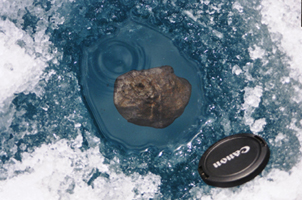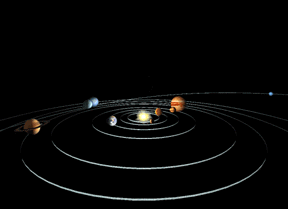Click on image for full size
Image courtesy of the University of Western Ontario and the University of Calgary
A Look at the Solar System's Past - the Tagish Meteorite
News story originally written on September 24, 2001
On January 18, 2000, a bright fireball streaked through the skies of northern Canada as a meteorite entered the atmosphere and fell to Earth, eventually coming to rest on the surface of a frozen lake (Tagish Lake, in British Columbia). The meteorite was the largest on record to ever fall in Canada, and has turned out to be one of the most scientifically significant meteorites to fall anywhere in the world.
When the meteorite was first recovered from the lake ice, it was classified as a "carbonaceous chondrite", which is a very rare family of carbon-rich, charcoal-like meteorites. Carbonaceous chondrites make up only three percent of meteorites that have been recovered, and are thought to be geological "snapshots" of what the chemical composition of the space environment was like long ago. This means that these meteorites represent something like a time capsule, as they were formed early in the development of the solar system and have remained relatively undisturbed, except when their paths bring them falling to Earth. By studying these meteorites, scientists can get an idea of what the chemical composition of the early solar system was like.
The Tagish Lake Meteorite is the best example of a carbonaceous chondrite ever found on Earth, but it attracted even more attention when a small sample of the interior of the meteorite was analyzed chemically. This study, recently conducted by scientists at Arizona State University, showed that the Tagish Lake samples are chemically very primitive, containing few of the wide variety of organic compounds found in other carbonaceous chondrites. As a point of contrast, the famous Murchison Meteorite, which fell in Australia in 1969, contained amino acids and other complex organic molecules. Instead, the Tagish Lake Meteorite contained molecular carbon (in the form of fullerenes, or "buckyballs") and pockets of helium and argon in a ratio similar to the ratio found in the gas and dust clouds from which the planets would have formed.
Because the Tagish Lake samples have proven to be so primitive chemically, they are scientists' best clues as to what the early solar system was like chemically. Neil MacRae, an Earth Sciences professor at the University of Western Ontario and one of the authors on an earlier study of the Tagish Lake Meteorite summed it best: "The standard composition of the solar system is partly defined by the most primitive meteorite in existence. If our results are proven correct, this new discovery will ultimately change that definition."















